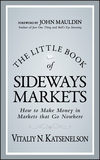Little Book of Sideways Markets
 The Little Book of Sideways Markets: How to Make Money in Markets that Go NowhereISBN: 978-0-470-93293-3
Hardcover
256 pages
December 2010
This is a Print-on-Demand title. It will be printed specifically to fill your order. Please allow an additional 10-15 days delivery time. The book is not returnable.
Learn more about this book
|
|||||||
Little Book of Sideways Markets
In THE LITTLE BOOK OF SIDEWAYS MARKETS, respected value investor Vitaliy Katsenelson explains how to survive a stagnant market that’s neither bull nor bear but instead what he calls a cowardly lion—it displays occasional bursts of bravado but is ultimately overcome by fear. For the next decade or so, the Dow Jones Industrial Average and the S&P 500 index will likely do what they did over the preceding decade: go up and down, setting all-time highs and multiyear lows along the way. But at the end of the ride, index and buy-and-hold stock investors, having experienced ups and down and swings akin to those on an amusement park ride, will find themselves pretty much back where they started in 2000. This is all well and fine for visitors to Six Flags, but not for investors.
According to Katsenelson, every long-lasting bull market of the past two centuries was followed by a sideways market that lasted about 15 years. The Great Depression was the only exception. Despite common perception, secular markets spend a lot of time in bull or sideways phases, and roughly an equal amount in each. They visit the bear cage only on very rare occasions. This doesn’t happen because the market gods want to play a practical joke but because stock prices are driven in the long run by two factors: earnings growth (or decline) and price-earnings expansion (or contraction). Prolonged bull markets start with below-average P/Es and end with above-average ones, but sideways markets rid us of the high P/Es caused by the bulls, taking them down to and actually below the mean. P/E compression—a staple of sideways markets—and earnings growth work against each other, resulting in zero (or near-zero) price appreciation plus dividends.
So how does one survive in a sideways market? Katsenelson suggests becoming a born-again value investor. “Traditional buy-and-forget-to-sell investing is not dead but is in a coma waiting for the next secular bull market to return—and it’s still far, far away.”
Katsenelson argues that investors must adjust their strategies and offers this advice:
- Increase the margin of safety. Value investors seek a margin of safety by buying stocks at a significant discount to protect them from overestimating the “E.” In this environment, that margin needs to be even more beefed up to account for the impact of constantly declining P/Es.
- Don’t fall into the relative valuation trap. Many stocks will appear cheap based on historical valuations, but past bull market valuations will not be helpful again for a long time. Absolute valuation tools such as discounted cash flow analysis should carry more weight.
- Don’t time the market. Though market timing is alluring, it is very difficult to do well. Instead, value individual stocks, buying them when they are cheap and selling them when they become fairly valued.
- Don’t be afraid of cash. Secular bull markets taught investors not to hold cash, as the opportunity cost of doing so was very high. The opportunity cost of cash is a lot lower during a sideways market. And staying fully invested will force investors to own stocks of marginal quality or ones that don’t meet your heightened margin of safety.
THE LITTLE BOOK OF SIDEWAYS MARKETS explains what sideways markets are, discusses how they will impact the market, and provides a framework for stock analysis that takes into account the lingering effects of the Great Recession, the financial conditions crisis of 2008-2009, and the coming impact of the economic conditions in Japan and China so that investors will triumph even when the market is stalled.





